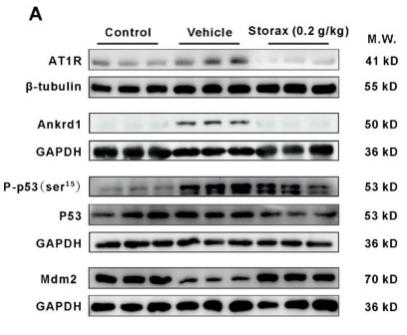ANKRD1 Antibody - #AF0677
| Product: | ANKRD1 Antibody |
| Catalog: | AF0677 |
| Description: | Rabbit polyclonal antibody to ANKRD1 |
| Application: | WB IF/ICC |
| Cited expt.: | WB |
| Reactivity: | Human, Mouse, Rat |
| Prediction: | Pig, Bovine, Horse, Rabbit, Dog, Chicken, Xenopus |
| Mol.Wt.: | 36kDa; 36kD(Calculated). |
| Uniprot: | Q15327 |
| RRID: | AB_2834258 |
Product Info
*The optimal dilutions should be determined by the end user. For optimal experimental results, antibody reuse is not recommended.
*Tips:
WB: For western blot detection of denatured protein samples. IHC: For immunohistochemical detection of paraffin sections (IHC-p) or frozen sections (IHC-f) of tissue samples. IF/ICC: For immunofluorescence detection of cell samples. ELISA(peptide): For ELISA detection of antigenic peptide.
Cite Format: Affinity Biosciences Cat# AF0677, RRID:AB_2834258.
Fold/Unfold
ALRP; ANKR1_HUMAN; ANKRD 1; ANKRD1; Ankyrin repeat domain 1 (cardiac muscle); Ankyrin repeat domain containing protein 1; Ankyrin repeat domain-containing protein 1; bA320F15.2; C 193; C193; Cardiac ankyrin repeat protein; CARP; CVARP; Cytokine inducible nuclear protein; Cytokine-inducible gene C-193 protein; Cytokine-inducible nuclear protein; HA1A2; Liver ankyrin repeat domain 1; MCARP; OTTHUMP00000020084;
Immunogens
A synthesized peptide derived from human ANKRD1, corresponding to a region within the internal amino acids.
Mainly expressed in activated vascular endothelial cells. To a lower extent, also expressed in hepatoma cells.
- Q15327 ANKR1_HUMAN:
- Protein BLAST With
- NCBI/
- ExPASy/
- Uniprot
MMVLKVEELVTGKKNGNGEAGEFLPEDFRDGEYEAAVTLEKQEDLKTLLAHPVTLGEQQWKSEKQREAELKKKKLEQRSKLENLEDLEIIIQLKKRKKYRKTKVPVVKEPEPEIITEPVDVPTFLKAALENKLPVVEKFLSDKNNPDVCDEYKRTALHRACLEGHLAIVEKLMEAGAQIEFRDMLESTAIHWASRGGNLDVLKLLLNKGAKISARDKLLSTALHVAVRTGHYECAEHLIACEADLNAKDREGDTPLHDAVRLNRYKMIRLLIMYGADLNIKNCAGKTPMDLVLHWQNGTKAIFDSLRENSYKTSRIATF
Predictions
Score>80(red) has high confidence and is suggested to be used for WB detection. *The prediction model is mainly based on the alignment of immunogen sequences, the results are for reference only, not as the basis of quality assurance.
High(score>80) Medium(80>score>50) Low(score<50) No confidence
Research Backgrounds
May play an important role in endothelial cell activation. May act as a nuclear transcription factor that negatively regulates the expression of cardiac genes. Induction seems to be correlated with apoptotic cell death in hepatoma cells.
Nucleus.
Mainly expressed in activated vascular endothelial cells. To a lower extent, also expressed in hepatoma cells.
References
Application: WB Species: Rat Sample: cardiac tissue
Restrictive clause
Affinity Biosciences tests all products strictly. Citations are provided as a resource for additional applications that have not been validated by Affinity Biosciences. Please choose the appropriate format for each application and consult Materials and Methods sections for additional details about the use of any product in these publications.
For Research Use Only.
Not for use in diagnostic or therapeutic procedures. Not for resale. Not for distribution without written consent. Affinity Biosciences will not be held responsible for patent infringement or other violations that may occur with the use of our products. Affinity Biosciences, Affinity Biosciences Logo and all other trademarks are the property of Affinity Biosciences LTD.
